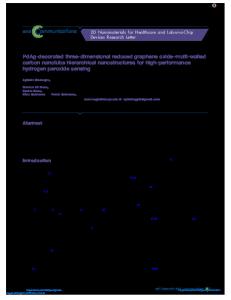MnO 2 Decorated Three Dimensional Graphene Heterostructures for Supercapacitor Electrodes
- PDF / 245,017 Bytes
- 6 Pages / 432 x 648 pts Page_size
- 103 Downloads / 407 Views
MnO2 Decorated Three Dimensional Graphene Heterostructures for Supercapacitor Electrodes Wei Wang1, 3, Shirui Guo2, Mihrimah Ozkan2,3, Cengiz S. Ozkan1, 4 1 Materials Science and Engineering, University of California, Riverside, CA 92521, U.S.A. 2 Chemistry, University of California, Riverside, CA 92521, U.S.A. 3 Electrical Engineering, University of California, Riverside, CA 92521, U.S.A. 4 Mechanical Engineering, University of California, Riverside, CA92521, U.S.A. ABSTRACT Supercapacitors are promising candidates for alternative energy storage applications since they can store and deliver energy at relatively high rates. In this work, we integrated large area chemical vapor deposition (CVD) grown three dimensional graphene heterostructures with high capacitance metal oxides (MnO2) to fabricate highly conductive, large surface-area composite thin films. Uniform, large area 3D graphene heterostructures layers were produced by a one-step CVD on nickel foams. MnO2 nanowires were deposited on the as-obtained 3D graphene heterostructures film by a simple chemical bath depostion process. The oxide loading of the 3D graphene/MWNTs/MnO2 nanowires (GMM) composite films can be simply controlled by deposition time and nanowire solution concentration. The surface morphology was investigated by scanning electron microscopy (SEM) and scanning transmission electron microscopy (STEM), and Energy-dispersive X-ray spectroscopy (EDS) was performed to characterize the MnO2 on the surface of the film. By introducing the fast surface redox reactions into the graphene heterostructures film via integrating pseudocapacitive material like MnO2, the capacitive ability of the system enhanced dramatically. Supercapacitor was fabricated based on the 3D graphene heterostructures /MnO2 hybrid film electrodes; the measurements of cyclic voltammetry, and electrochemical impedance spectroscopy (EIS) are conducted to determine its performance for the electrodes of supercapacitors. INTRODUCTION The supercapacitor (SC) is a promising high performance energy storage system due to its relatively fast rate of energy storage and delivery. Its high power density and excellent cycling lifetime make the supercapacitors suitable for a wide variety of applications like electric or hybrid electric vehicles [1, 2]. However, the SCs based on these carbonaceous materials are mostly not able to provide suffcient energy density and the high current handlibility [3]. Therefore, to solve this problem, pseudo-capacitive materials are applied to introduce the fast surface redox reactions. Among all redox-active materials, MnO2 appears to be the most promising materials for SCs with the advantages of relatively low cost, simple and scalable synthesis process, environmental friendliness, and can be charge-discharged repidly [4, 5]. Previously we reported the growth of high-quality graphene/multi-walled carbon nanotubes (MWNTs) hybrid hierarchical nanostructure on high porosity nickel foam via a one-step ambient pressure chemical vapor deposition (APCVD). This novel three-
Data Loading...











